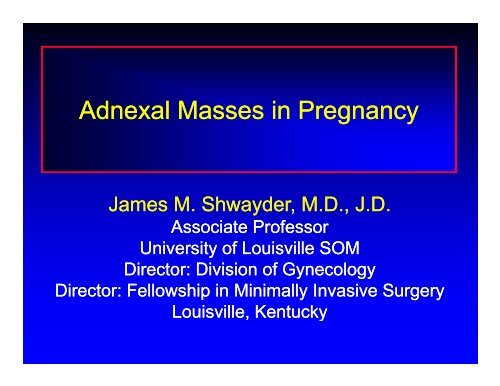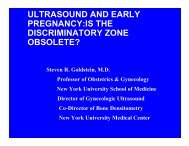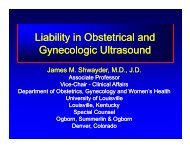Adnexal Masses in Pregnancy - Cmebyplaza.com
Adnexal Masses in Pregnancy - Cmebyplaza.com
Adnexal Masses in Pregnancy - Cmebyplaza.com
Create successful ePaper yourself
Turn your PDF publications into a flip-book with our unique Google optimized e-Paper software.
<strong>Adnexal</strong> <strong>Masses</strong> <strong>in</strong> <strong>Pregnancy</strong><br />
James M. Shwayder, M.D., J.D.<br />
Associate Professor<br />
University of Louisville SOM<br />
Director: Division i i of Gynecology<br />
Director: Fellowship <strong>in</strong> M<strong>in</strong>imally Invasive Surgery<br />
Louisville, Kentucky
<strong>Adnexal</strong> <strong>Masses</strong> <strong>in</strong> <strong>Pregnancy</strong><br />
James M. Shwayder, MD, JD<br />
Disclosures:<br />
• Cook OB-Gyn:<br />
• Philips Ultrasound:<br />
• Ethicon EndoSurgery:<br />
Honorarium, Royalties<br />
Honorarium<br />
Honorarium, Fellowship Support
Objectives<br />
• Discuss the use of ultrasound <strong>in</strong><br />
adnexal evaluation dur<strong>in</strong>g pregnancy<br />
• Diagnosis<br />
• Patient counsel<strong>in</strong>g<br />
• Procedure plann<strong>in</strong>g<br />
• Case examples
<strong>Adnexal</strong> <strong>Masses</strong> <strong>in</strong> <strong>Pregnancy</strong><br />
• Age<br />
• Morphology<br />
• Doppler<br />
• Tumor markers
Age Related Risk of Malignancy of<br />
an Ovarian Tumor (959 Patients)<br />
Malignant<br />
Benign<br />
Age, Yrs N % N % RM (%) RR<br />
< 20 14 5 446 24.1 29<br />
2.9<br />
21 - 30 12 4 132 19 8.3 1.0<br />
31 - 40 21 8 138 20 13.2 1.6<br />
41 - 50 42 16 180 15 43.3 2.3<br />
51 - 60 81 30 106 15 43.3 5.2<br />
61 - 70 68 25 56 8 54.8 66<br />
6.6<br />
> 71 33 12 32 5 50.8 6.1<br />
Rate of malignancy (RM)<br />
Relative Risk of malignancy (PR)<br />
M<strong>in</strong>aretzis et al. Gynecol Obstet Invest 1994; 38, 140-144144
Morphology<br />
Differentiat<strong>in</strong>g Benign from Malignant Ovarian<br />
Lesions<br />
Author n PPV<br />
NPV<br />
Sens<br />
Spec<br />
Koboyashi (1976) 406 31 93 71 73<br />
Meire et al (1978) 51 83 91 83 91<br />
Pussell et al (1980) 25 83 91 83 84<br />
Hermann et al (1987) 241 75 95 82 93<br />
F<strong>in</strong>kler et al (1988) 102 88 81 62 95<br />
Benacerraf et al (1990) 100 72 91 80 87<br />
Granburg et al (1990) 180 74 95 82 92<br />
Sassone et al (1991) 143 37 100 100 83
Color Flow Doppler<br />
• Significant ifi overlap <strong>in</strong> blood flow<br />
patterns between pregnancy<br />
and malignancy<br />
• False positive rate ~ 50%<br />
Wheeler and Fleischer. J Ultrasound Med 1997;16:425-28.<br />
28.
Tumor Markers<br />
• CA125 Epithelial ovarian cancer (80%)<br />
• CA 19-9<br />
• AFP<br />
Exception: muc<strong>in</strong>ous tumors<br />
Muc<strong>in</strong>ous tumors<br />
Germ cell tumors<br />
Endodermal s<strong>in</strong>us tumor<br />
• β-hCG<br />
Germ cell tumors<br />
Choriocarc<strong>in</strong>oma<br />
• LDH<br />
Dysgerm<strong>in</strong>oma
26 y.o. G2P1001<br />
• Ultrasound for early dat<strong>in</strong>g<br />
• Poor dates
26 y.o. G2P1001 at 9w4d
RI = 0.81<br />
PI = 2.27
26 y.o. G2P1001 at 9w4d<br />
US for early dates<br />
• S<strong>in</strong>gle, viable IUP<br />
• CRL =2.8 cm c/w 9w4d<br />
• Right ovary: Corpus luteum 1.9 x1.5 cm<br />
• Left ovary: 13.23 x 12.19 x 9.91 cm cyst,<br />
unilocular with <strong>in</strong>ternal echoes, a th<strong>in</strong><br />
septation and wall nodularity.
26 y.o. G2P1001 at 9w4d<br />
• Probable diagnosis<br />
• Serous or muc<strong>in</strong>ous cystadenoma<br />
• Should we operate<br />
• Let’s talk
RISKS TO THE<br />
MOTHER<br />
RISKS TO THE<br />
PREGNANCY
<strong>Adnexal</strong> <strong>Masses</strong> <strong>in</strong> <strong>Pregnancy</strong><br />
Why operate<br />
• Possible malignancy<br />
• Prevent <strong>com</strong>plications<br />
• Torsion<br />
• Rupture<br />
• Obstruction of labor
<strong>Adnexal</strong> <strong>Masses</strong> <strong>in</strong> <strong>Pregnancy</strong><br />
Risks of Surgery<br />
• Spontaneous miscarriage<br />
i<br />
• Rupture of membranes<br />
• Preterm labor<br />
• Preterm birth
<strong>Adnexal</strong> <strong>Masses</strong> <strong>in</strong> <strong>Pregnancy</strong><br />
• 1-4 % of pregnant women are diagnosed with<br />
an adnexal mass 1,2<br />
• 82% 3 to 94% 4 rate of spontaneous resolution<br />
1 Hill et al. Am J Obstet Gynecol 1998; 179: 703-707. 707.<br />
2<br />
Nelson et al. J Cl<strong>in</strong> Ultrasound 1986; 14: 509-512.<br />
512.<br />
3 Thornton and Wells. Obstet Gynecol 1987;69:717-21.<br />
4 Grimes et al. Am J Obstet Gynecol 1954;68:594-605. 605.
<strong>Adnexal</strong> <strong>Masses</strong> <strong>in</strong> <strong>Pregnancy</strong><br />
• 82% 1 to 94% 2 rate of spontaneous resolution<br />
• Particularly simple, unilocular cysts<br />
• Most of the others are a corpus luteum and<br />
resolve by 16 weeks<br />
• Expectant management is appropriate for<br />
adnexal masses < 6 cm <strong>in</strong> the first trimester 1,2<br />
1 Thornton and Wells. Obstet Gynecol 1987;69:717-21.<br />
2 Grimes et al. Am J Obstet Gynecol 1954;68:594-605. 605.
<strong>Adnexal</strong> <strong>Masses</strong> <strong>in</strong> <strong>Pregnancy</strong><br />
• 1–8% of persistent masses are malignant<br />
• Traditionally, most masses were treated by<br />
laparotomy at 16-20 weeks of gestation<br />
Whitecar et al. Am J Obstet Gynecol 1999;181:19-24.
<strong>Adnexal</strong> <strong>Masses</strong> <strong>in</strong> <strong>Pregnancy</strong><br />
Surgery vs. Observation<br />
• Retrospective review of 127,177<br />
deliveries i between 1999 – 2003<br />
• <strong>Adnexal</strong> mass > 5 cm <strong>in</strong> 63 (0.05%)<br />
• Pathology available <strong>in</strong> 59 (94%)<br />
• Lost to follow-up: 4<br />
• Antepartum surgery: 17 (29%)<br />
• Postpartum surgery: 42 (71%)<br />
Schmeler et al. Obstet Gynecol 2005; 105: 1098-1103. 1103.
<strong>Adnexal</strong> <strong>Masses</strong> <strong>in</strong> <strong>Pregnancy</strong><br />
Antepartum Surgery (n = 17)<br />
• Suspicion of malignancy 13 (76.5%)<br />
• Mixed cystic and solid <strong>com</strong>ponents<br />
• Septations<br />
• Papillary projections<br />
• Wall nodularity<br />
• Emergency surgery for torsion 4 (23.5%)<br />
• 68%of59masses<br />
6.8 • Surgery at 9, 13, 25, 34 weeks of gestation<br />
• PPROM at 23 w chorioamnionitis<br />
Schmeler et al. Obstet Gynecol 2005; 105: 1098-1103. 1103.
<strong>Adnexal</strong> <strong>Masses</strong> <strong>in</strong> <strong>Pregnancy</strong><br />
Pathologic diagnosis i (n=59)<br />
Pathologic Diagnosis # %<br />
Dermoid 25 42.3<br />
Functional cyst 9 15.3<br />
Cystadenoma 9 15.3<br />
Adenofibroma 3 50 5.0<br />
Fibroid 4 6.8<br />
Malignancy 4 68 6.8<br />
Endometrioma 3 5.1<br />
Borderl<strong>in</strong>e tumor (LMP) 1 17 1.7<br />
Resolution of mass 1 1.7
<strong>Adnexal</strong> <strong>Masses</strong> <strong>in</strong> <strong>Pregnancy</strong><br />
Pathologic diagnosis i (7 studies)<br />
Pathologic Diagnosis %<br />
Dermoid 25<br />
Functional cyst, paraovarian 17<br />
Serous cystadenoma 14<br />
Muc<strong>in</strong>ous cystadenoma 11<br />
Endometrioma 8<br />
Malignancy 28 2.8<br />
Borderl<strong>in</strong>e tumor (LMP) 3<br />
Leiomyoma 2<br />
Hoover and Jenk<strong>in</strong>s.Am<br />
JObstet<br />
Gynecol 2011;205(2):97-102.
<strong>Adnexal</strong> <strong>Masses</strong> <strong>in</strong> <strong>Pregnancy</strong><br />
Study<br />
AP<br />
Surgery<br />
Malignancy<br />
% Cancer LMP<br />
Complications<br />
SAB<br />
Torsion<br />
Bernard 1988-1993 79 0 3.1 NA 3.1<br />
Platek 1988-1994 59 0 0 3.2 0<br />
Bromley 1988-1995 19 0.8 0 0 0.8<br />
Whitecar 1989-1994 66 3.1 3.1 1.5 5.4<br />
Sherard 1990-2002 55 5.0 8.3 4.7 1.8<br />
Schmeler 1990-2003 27 6.8 1.7 0 6.8<br />
Yen 1990-2004 44 2.3 3.4 14.8
<strong>Adnexal</strong> <strong>Masses</strong> <strong>in</strong> <strong>Pregnancy</strong><br />
Risk of Malignancy<br />
Size Matters
<strong>Adnexal</strong> <strong>Masses</strong> <strong>in</strong> <strong>Pregnancy</strong><br />
Risk Malignancy<br />
• Retrospective review of 1990-2002<br />
• 60 patients (0.15% of pregnancies)<br />
• EGA at diagnosis<br />
12 weeks<br />
• EGA at surgery<br />
20 weeks<br />
• Malignancy (CA + LMP) 13.3%<br />
• % CA 3 37% 5.0%<br />
• % LMP 5 63% 8.3%<br />
Sherard et al. Am J Obstet Gynecol 2003;189:358-63.
<strong>Adnexal</strong> <strong>Masses</strong> <strong>in</strong> <strong>Pregnancy</strong><br />
Risk of Malignancy<br />
Category<br />
Size<br />
Malignant<br />
11.5 cm<br />
Benign<br />
7.6 cm<br />
Sherard et al. Am J Obstet Gynecol 2003;189:358-63.
<strong>Adnexal</strong> <strong>Masses</strong> <strong>in</strong> <strong>Pregnancy</strong><br />
Risk of Malignancy<br />
Size<br />
> 10 cm<br />
Growth > 0.35 cm/week<br />
Odds of Malignancy<br />
11.2<br />
8.77% vs 0.85%<br />
10.2<br />
8.33% vs 0.88%<br />
Yen et al. Fertil Steril 2009;91:1895-1902. 1902.
<strong>Adnexal</strong> <strong>Masses</strong> <strong>in</strong> <strong>Pregnancy</strong><br />
Risk Analysis of Torsion and Malignancy<br />
• Retrospective review of 1990-2004<br />
• 213 patients<br />
t<br />
• 174 were followed dur<strong>in</strong>g pregnancy<br />
with ithakno known nt tumor<br />
• Torsion 24 13.8%<br />
• Ovarian cancer 4 23%<br />
2.3%<br />
• Malignancy (CA+LMP) 6 3.4%<br />
Yen et al. Fertil Steril 2009;91:1895-1902. 1902.
<strong>Adnexal</strong> <strong>Masses</strong> <strong>in</strong> <strong>Pregnancy</strong><br />
Risk of Torsion - Size<br />
Size<br />
All<br />
Patients<br />
Known<br />
tumors<br />
Overall 14.8% 13.8%<br />
5-10 cm 69.7%<br />
6-8 cm 51.5% 22.4%*<br />
*<strong>com</strong>pared to 9.6% for tumors of other sizes<br />
Yen et al. Fertil Steril 2009;91:1895-1902.<br />
1902.
<strong>Adnexal</strong> <strong>Masses</strong> <strong>in</strong> <strong>Pregnancy</strong><br />
Risk of Torsion<br />
• No difference<br />
• Age<br />
• Parity<br />
• Right = Left<br />
• Size <strong>in</strong> known and unknown<br />
tumors that undergo torsion<br />
Yen et al. Fertil Steril 2009;91:1895-1902. 1902.
<strong>Adnexal</strong> <strong>Masses</strong> <strong>in</strong> <strong>Pregnancy</strong><br />
Risk of Torsion - EGA<br />
Gestational Age<br />
Percentage of<br />
torsions<br />
10-17 weeks 60.0%<br />
15-16 weeks 36.7%<br />
> 20 weeks 5.9%<br />
Yen et al. Fertil Steril 2009;91:1895-1902. 1902.
<strong>Adnexal</strong> <strong>Masses</strong> <strong>in</strong> <strong>Pregnancy</strong><br />
Surgical Complications<br />
Laparotomy at 16-20 weeks (n=60)<br />
Category<br />
Percentage<br />
Preterm Birth Rate 9%<br />
Miscarriage Rate 4.7%<br />
Sherard et al. Am J Obstet Gynecol 2003;189:358-63.
<strong>Adnexal</strong> <strong>Masses</strong> <strong>in</strong> <strong>Pregnancy</strong><br />
Surgical Complications<br />
Laparotomy at 6-41 weeks (n=34)<br />
Category<br />
(Surgery <strong>in</strong> 2 nd Trimester)<br />
Percentage<br />
Preterm Birth Rate 58% 5.8%<br />
Miscarriage Rate 2.9%<br />
Balci et al. J Obstet Gynaecol Res. 2008;34:524-28. 28.
<strong>Adnexal</strong> <strong>Masses</strong> <strong>in</strong> <strong>Pregnancy</strong><br />
Surgical Complications<br />
Laparoscopy py<br />
2 ND Trimester<br />
Author<br />
Miscarriage<br />
PPROM<br />
Preterm Labor<br />
Yeun and Chang 1<br />
n=6<br />
Tazuke et al. 2<br />
n=9<br />
Stepp et al.<br />
3<br />
n=11<br />
0% 0% 0%<br />
0% 11.1% 0%<br />
0% 0% 0%<br />
1 Yuen and Chang. Acta Obstet Gynecol Scand 1997;76:173-76.<br />
76.<br />
2 Tazuke et al. J Am Assoc Gynecol Laparosc 1997;4(5):605-608. 608.<br />
3 Stepp et al. J Am Assoc Gynecol Laparosc 2003;10(1):55-59. 59.
26 y.o. G2P1001 at 13 weeks<br />
• Probable bl diagnosis<br />
i<br />
• Serous or muc<strong>in</strong>ous cystadenoma<br />
• Should we operate<br />
• Yes<br />
• Laparoscopy v. Laparotomy<br />
• Surgeon dependant d 123<br />
1,2,3<br />
1. Moore and Smith. J Reprod Med. 1999; 44: 97-100.<br />
2. Parker et al. Am J Obstet Gynecol. 1996: 174; 1499-15011501<br />
3. Roman et al. J M<strong>in</strong> Invasive Gynecol. 2005; 21: 377-78. 78.
26 y.o. G2P1001 at 13 weeks<br />
• L/S left salp<strong>in</strong>goophorectomy<br />
• Serous cystadenoma of LMP<br />
• No <strong>com</strong>plications<br />
• Delivered at term
21 y.o. G1P0<br />
• LMP = unknown<br />
• Exam: Palpable cul-de<br />
de-sac<br />
mass<br />
• No FHT’s by Doppler
FHR = 160 bpm
OUTCOME<br />
• Resolved spontaneously<br />
• Probable luteal cysts
22 y.o. G1P0<br />
• Enters c/o abdom<strong>in</strong>al pa<strong>in</strong><br />
• EGA ~ 5 weeks
22 y.o. G1P0<br />
• Laparoscopy<br />
• Torsion – right ovary<br />
• Dermoid
24 y.o. G2P1001<br />
• Presents for ultrasound<br />
• Unknown dates
RIGHT OVARY
PI = 0.93<br />
RI = 0.57
24 y.o. G2P1001<br />
• Laparoscopy<br />
• Post-partum<br />
• Bilateral ovarian cystectomies<br />
• Dermoids
26 y.o. G1P0<br />
13w4d
26 yo y.o. G1P0<br />
13w4d<br />
• LSO<br />
• Right ovarian cystectomy<br />
• Bilateral endometriomas, the<br />
right was decidualized
40 y.o. G2P1001<br />
13w2d<br />
• Ultrasound for <strong>com</strong>plex mass on<br />
first trimester study
13w2d
13w2d
13w2d
13w2d
13w2d
40 y.o. G2P1001<br />
13w2d<br />
• Laparoscopic p<br />
LSO<br />
• Dermoid
28 y.o. G3P2002<br />
• Rout<strong>in</strong>e ultrasound for dat<strong>in</strong>g<br />
• 14w5d
RI = 0.73
Color Flow Doppler<br />
• Significant ifi overlap <strong>in</strong> blood flow<br />
patterns between pregnancy<br />
and malignancy<br />
• False positive rate ~ 50%<br />
Wheeler and Fleischer. J Ultrasound Med 1997;16:425-28. 28.
28 y.o. G3P2002<br />
History<br />
• Prior laparotomy<br />
• Stage III-B Serous tumor LMP<br />
• Elected on observation
28 y.o. G3P2002<br />
• Vag<strong>in</strong>al delivery at term<br />
• F<strong>in</strong>al stag<strong>in</strong>g g post-partumpartum<br />
• Serous tumor of LMP<br />
• No evidence of metastasis
37 y.o. G4P3003<br />
• Referred ee ed for adnexal a<br />
mass<br />
identified on ultrasound at<br />
planned amniocentesis<br />
• US EGA = 15w3d
37 y.o. G4P3003<br />
15w3d
37 y.o. G4P3003<br />
23w2d
23w2d
23w2d
23w2d
23w2d
23w2d
37 y.o. G4P3003<br />
26w2d
26w2d
26w2d
26w2d
26w2d
37 y.o. G4P3003<br />
34w2d
34w2d
34w2d
34w2d
37 y.o. G4P3003<br />
• Cesarean delivery at 39 wks<br />
• Left salp<strong>in</strong>go-oophorectomy<br />
oophorectomy<br />
• Frozen: Cannot rule-out borderl<strong>in</strong>e<br />
tumor<br />
• Permanent: Serosal endometriosis<br />
and a serous tumor of LMP
<strong>Adnexal</strong> <strong>Masses</strong> <strong>in</strong> <strong>Pregnancy</strong><br />
Summary<br />
• 82%-94% of masses detected t d <strong>in</strong><br />
the 1 st trimester resolve<br />
spontaneously<br />
• Observation is appropriate with<br />
masses < 6 cm <strong>in</strong> size
<strong>Adnexal</strong> <strong>Masses</strong> <strong>in</strong> <strong>Pregnancy</strong><br />
Summary-Malignancy<br />
Of those that persist<br />
• Risk of malignancy 1-7%<br />
• CA + LMP 1-13% 13%<br />
• Risk greatest<br />
• Size > 10 cm<br />
• Growth > 1 cm <strong>in</strong> 3 weeks
<strong>Adnexal</strong> <strong>Masses</strong> <strong>in</strong> <strong>Pregnancy</strong><br />
Summary-Torsion<br />
• Risk of torsion 1-15% 15%<br />
• 5-10 cm 69%<br />
• Tim<strong>in</strong>g go of toso<br />
torsion<br />
• 10-1717 weeks 60%<br />
• 15-1616 weeks 39%<br />
• > 20 weeks 6%
<strong>Adnexal</strong> <strong>Masses</strong> <strong>in</strong> <strong>Pregnancy</strong><br />
Summary<br />
Surgical risks (at laparotomy)<br />
• Preterm Birth Rate 9%<br />
• Miscarriage Rate 4.7%<br />
• These risks are reduced with<br />
laparoscopy
<strong>Adnexal</strong> <strong>Masses</strong> <strong>in</strong> <strong>Pregnancy</strong><br />
Indications for Surgery<br />
• Strong suspicion for malignancy<br />
• Increased risk of<br />
torsion/rupture/obstruction <strong>in</strong> labor<br />
• Symptomatic<br />
ti
Thank You






